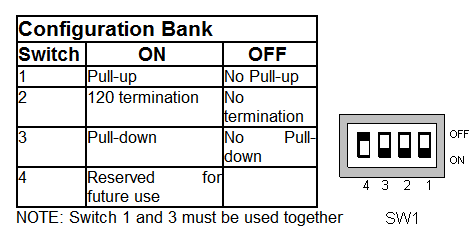Danfoss VLT5000 Protocol
See also: Help for Serial Protocols
Overview
The Danfoss VLT5000 serial downloadable protocol is for communication between the Danfoss inverters and an OCS. This is a Master/Slave protocol.
CSCAPE Configuration
To configure OCS for the Danfoss protocol, select the Protocol Configuration from the Program menu in CSCAPE software. Select the appropriate protocol type on the desired port. To make sure that the Software is able to configure the equipment for the correct protocol, make sure the Danfoss.dll file is in Protocols directory of the current working/open Cscape.
Serial Port Configuration
The default settings are 9600 baud, Even parity, Eight data bits, One stop bit, RS485 communication, Multidrop Half duplex, and No handshaking.
These settings are intended as a guide and are correct at time of writing. Refer to your VLT5000 documentation for further details and modifications regarding configuring the RS485 Option port on the VLT5000.
The VLT5000 RS485 baud rate is specified in parameter 501.
Selecting Device Register
Enter the desired parameter address in the Device Register field or use " > " button to select the desired parameter.
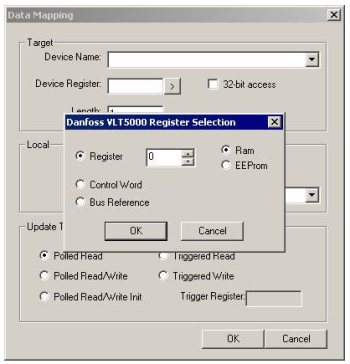
Protocol Revisions
The Horner APG VLT5000 protocol currently supports read and write of:
EEPROM Parameters : 0–999
RAM Parameters: 0–999
Control Word
Bus Reference
Block Start
The block start or location is the actual parameter number for EEPROM and RAM Parameters. It should always be set to 0 when accessing the Control Word or Bus Reference.
Block Size
All register types in the current protocol implementation accesses data as multiples of 32 Bit words.
Node Address
The RS485 node address for the drive is specified in parameter 500.
RAM/EEPROM Parameters
Parameter access is either via the current RAM based settings or writing direct to the EEPROM settings to effect changes which will be retained during drive power down.
It is important that EEPROM parameters are used only where necessary since EEPROM has a defined number of write cycles.
NOTE: Click here for latest Danfoss Parameter List (as of March 10, 2022), and please see the https://www.danfoss.com/en-us/ for updates.
Network Communication Errors
In order to access the Network statistics, user must assign the “Network status register” in network configuration. The table below gives the details of statistics.
| Number | Statistics | Location | Description |
|---|---|---|---|
|
|
|
|
|
|
1 |
Update interval exceeded count |
%Rx |
This register explains number of times that the actual transaction scan time to complete all transactions exceeded specified update interval. Generally used as an indicator that an excessive number of triggered transfers or failed communication retries are occurring that is lengthening the expected transaction scan time.
If the Update interval is set to zero (update as fast as possible), this 32-bit register alternately specifies the actual transaction scan time in mSec resolution. |
|
2 |
No response count |
%R(x+2) |
This register explains number of times that a device(s) did not respond to a transaction. This includes ALL failed transaction, not just those after the retry count is exceeded. |
|
3 |
Corrupt Response Count |
%R(x+4) |
This register explains number of times that a device(s) returned an invalid or failed response to a transaction. This includes ALL failed.
Transaction, not just those after the retry count is exceeded. |
|
4 |
Valid Response Count |
%R(x+6) |
This register explains total number of valid responses. |
NOTE: %Rx: 32-bit network status register configured in Network configuration. For example: %R500(501).
Device Communication Errors
| Error | Error Number | Description |
|---|---|---|
|
INVALID_BLOCK |
-203 |
Invalid size for data type. |
|
NO_RESPONSE_FROM_PLC |
-204 |
Timeout while waiting for remote node response. |
|
INVALID_RESPONSE_FROM_PLC |
-205 |
Corrupted response from remote node. |
|
INVALID_INITIALISATION |
-207 |
Internal Error - Unable to open port. |
Connection Details
Illustrations below show the various end-of-cable connectors required:
| 25-Pin D-Type Male | 10-Pin Weidmuller
Cage Clamp |
8-Pin RJ 45 Plug | 9-Pin DB Male |
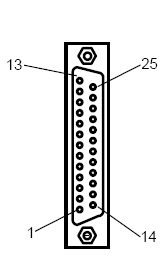
|

|
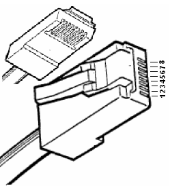
|
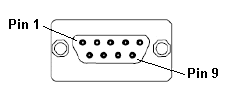
|
| CN1 | CN1 | MJ1/MJ2 | Port 1 |
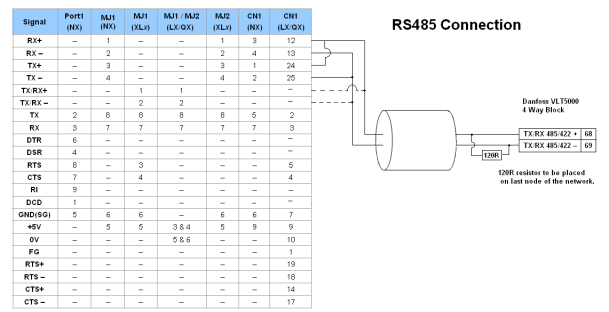
Port 1 — DB9 (Female at OCS end)
MJ1/MJ2 — RJ45 (Female at OCS end)
CN1 — 10-Pin Weidmuller Cage Clamp (Female at OCS end)
CN1 — DB25 (Female at OCS end)
NOTES:
-
Do not connect to unlisted pins.
-
Recommended Cable: Beldon 9503, twisted multipair, screened.
-
Connect the screens together at the shield / earth pin of the PLC.
